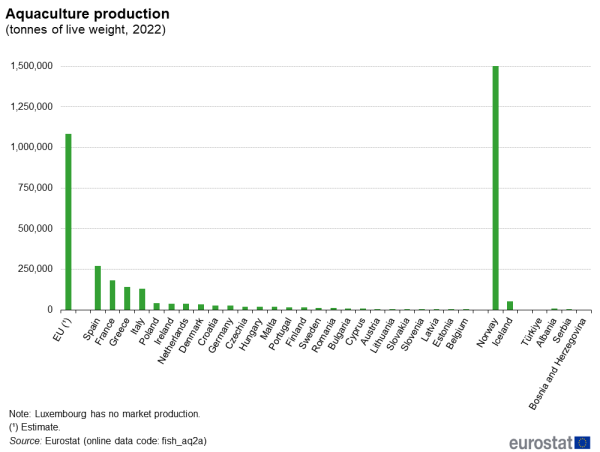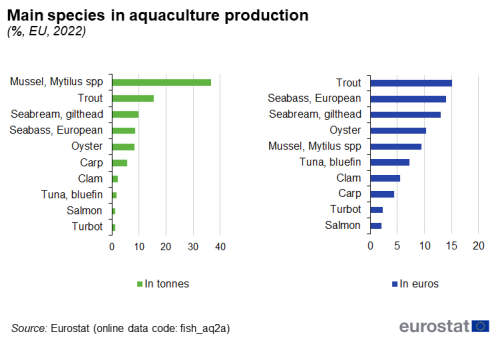Aquaculture statistics
Data extracted in April 2024.
Planned article update: 30 April 2025.
Highlights
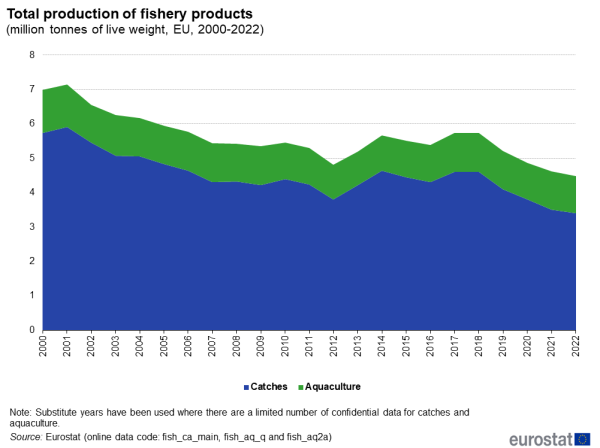
(million tonnes, EU, 2000–2022)
Source: Eurostat (fish_ca_main), (fish_aq_q) and (fish_aq2a)
This article gives an overview of recent statistics relating to aquaculture production in the European Union (EU).
The current common fisheries policy (CFP) of the EU[1] aims at an environmentally, economically and socially sustainable use of the common resource including aquaculture production.
Full article
EU Aquaculture
Aquaculture: almost 1.1 million tonnes of aquatic organisms yielded in EU in 2022, worth €4.8 billion
Aquaculture is the production of fish and other aquatic organisms like molluscs and crustaceans under controlled conditions; it is an alternative to catching wild fish and takes place both inland and in marine areas. Aquaculture is a key component of both the Common Fisheries Policy (CFP) and the Blue Growth [2] agenda to support sustainable growth in this sector.
Aquaculture farming in the EU yielded an estimated 1.1 million tonnes of aquatic organisms in 2022, corresponding to one-quarter of the output of European fisheries as a whole. This share was well below the global average in 2020 (about 49 % [3]), underlining the growth potential in the EU. In terms of output, the EU's aquaculture sector was the thirteenth largest worldwide, a little more than Thailand, with a 0.9 % share of the volume of global output in 2022. The value of aquaculture production in the EU was an estimated €4.8 billion in 2022, representing just over two-fifths of the total value of the EU's total production of fishery products (landings and aquaculture).
Four countries produced about two-thirds of the EU's aquaculture output volume and 62 % of its value
Four EU countries were responsible for about two-thirds (67.0 %) of the EU's total output in tonnes live weight of farmed aquatic organisms in 2022 (see Figure 1); Spain produced a little over one-quarter (an estimated 25.2 %) of the total, followed by France (17.0 %), Greece (13.0 %) and Italy (12.0 %).
Different aquatic organisms fetch different prices. For instance, the average first sale prices for mussels were about €1.1 per kg, for seabass around €7 per kg, and for tuna were about €18 per kg. Among EU countries, Greece had the highest value of aquaculture output in 2022 (an estimated €844 million), representing 17.4 % of the EU total. The value of output was next highest in Spain (€803 million), then in France (€791 million) and Italy (€553 million).
To put the EU's aquaculture industry in some perspective, the value of aquaculture output in Norway exceeded that of the whole of the EU; Norway produced 1.6 million tonnes of aquatic organisms (almost exclusively salmon), worth €10.7 billion in 2022. Norway was the world's sixth largest producer in aquaculture fish production in 2022, with a 2.7 % global share. It was also the world's second largest exporter of aquatic organisms, after China.
All fisheries production in the EU's landlocked countries (Czechia, Hungary, Austria and Slovakia) comes from aquaculture (Luxembourg has no market production) and about 93 % of total fisheries production in tonnes live weight in Slovenia. In general, aquaculture plays a major role in the countries around the Mediterranean Sea and the Black Sea, where sea-fishing is generally carried out using small-scale vessels with an average capacity lower than the EU average. This helps explain why aquaculture activity plays a relatively large role in the respective fisheries industries of Cyprus (accounting for 87.9 % of total fisheries production in tonnes live weight), Malta (87.7 %), Romania (77.9 %), Greece (68.9 %), Bulgaria (62.0 %) and Italy (49.5 %).
Organic Aquaculture
Organic aquaculture production on the rise in the EU
A number of EU countries farm aquaculture products according to organic criteria. In Ireland, the overwhelming majority (about 86 %) of aquaculture production (mainly salmon) was farmed organically in 2022. This was by far the highest proportion among EU countries (see Figure 2). Organic aquaculture production represented slightly more than one-third of total aquaculture production in 2022 in Slovenia (about 36 %) and Netherlands (about 35 %) and around one-quarter in Denmark (23 %).
These shares contrasted sharply with other EU countries, including the three with the highest level of aquaculture production in 2022; the share of organic aquaculture production in total aquaculture production was less than 3 % in Croatia, in Spain (about 1.5 %) and Greece, Latvia and Poland (all about 1 % in 2021).
Organic aquaculture production grew rapidly in a number of EU countries in the period between 2013 and 2022. Bulgaria, Germany, Spain, and Italy had no organic aquaculture in 2013 or very little, and grew their production to a combined 32 000 tonnes in 2022. Organic aquaculture production in Ireland was 18 000 tonnes more in 2022 than in 2013. By contrast, there were contractions in the organic aquaculture production of Lithuania and Hungary, the two countries together producing about 4 000 tonnes less.
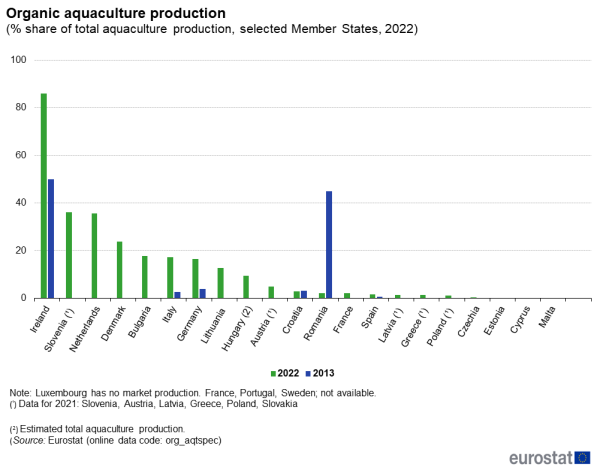
(% share of total aquaculture production, selected Member States, 2022)
Source: Eurostat (org_aqtspec)
Aquaculture species and specialisation
EU aquaculture production focused on finfish species and molluscs
Finfish (particularly trout, seabream, seabass, carp, tuna and salmon) and molluscs (particularly mussels, oysters and clams) together accounted for almost all of aquaculture production by weight in the EU in 2022.
Rainbow trout were the most valuable species farmed in the EU in 2022, accounting for about 15.1 % of all aquaculture production. The farmed production of seabass, seabream and oysters were the next most valuable (see Figure 3).
The production of algae and seaweed is an emerging sector of the blue economy. In addition to catches at sea, principally in the Atlantic, Northeast area, there is an increasing, albeit small, amount from aquaculture. These algae and seaweeds (including brown, red and green seaweeds) are used for example in food, feed production, industrial and pharmaceutical products. Although the volume of production of aquatic plants from aquaculture is small compared with catches and landings of aquatic plants (about 1 %), the value of production is relatively high. France was the main EU producer of farmed aquatic plants in 2022, which had an average price of about €20 per kg (wet weight). There is considerable specialisation in the market, with some EU countries like Spain and Portugal also targeting high value added cultivated species.
A high degree of country specialisation within the EU
The aquaculture sector is highly specialised within the EU.
Spain produced about 7 in every 10 tonnes of the EU's farmed Mediterranean mussels (Mytilus galloprovincialis) in 2022, largely due to its rafts in the estuaries of northern Spain using the 'off bottom' method. Blue mussels (Mytilus edulis) were farmed in the Atlantic, Northeast area by the France (about 51 % of the EU total in 2022), the Netherlands (about 24 %) and Ireland (about 15 %). Both 'off bottom' (preferred in Ireland) and 'on-bottom' methods (preferred in the Netherlands) were used.
Greece produced about 66 % of the EU's farmed production of gilthead seabream (Sparus aurata) and 51 % of European seabass (Dicentrarchus labrax) in 2022. Poland and Czechia were the leading EU producers of common carp (Cyprinus carpio), together producing about 53 % of the EU total. At world level, common carp was the fifth most farmed finfish species.
Within the EU, Pacific cupped oysters (Magallana gigas) were produced mainly in France (about 88 % of the total in 2022). Worldwide, about 33 % of all molluscs produced in 2022 were cupped oysters. Italy produced the vast majority (about 94 % in 2022) of the EU’s farmed Japanese carpet shell (Ruditapes philippinarum). At world level, it was the second most produced species among the molluscs (23 % of the total in 2022).
Atlantic bluefin tuna (Thunnus thynnus) were farmed in cages in only two EU countries, both in the Mediterranean Sea: Malta accounted for about 83 % of EU farmed production of bluefin tuna, the rest being produced in Croatia.
Ireland was responsible for about 98 % of 12 100 tonnes of farmed salmon in the EU in 2022. However, the quantity farmed was far below the 1.5 million tonnes farmed in Norway. At world level, Atlantic salmon (Salmo salar) was the eighth most produced finfish species.
The production of farmed rainbow trout (Oncorhynchus mykis) in the EU is something of an exception to the general observation about country specialisation; rainbow trout were farmed in 22 EU countries. About 51 % of the farmed live-weight of rainbow production in the EU in 2022 came from the combined output of France, Italy and Denmark. Fish were farmed either in inland freshwater (more than four-fifths of the total) or in the saltwater of the Atlantic, Northeast area, and mainly in tanks (about 50 %).
EU aquaculture volume and value
Steady level of EU aquaculture production volume but rising value
Between 2010 and 2022, the volume of EU aquaculture production remained relatively stable (see Figure 4.). However, the value of that production increased through higher prices, particularly between 2020 and 2022. Between 2010 and 2022, the value of aquaculture production rose by about 75 %.
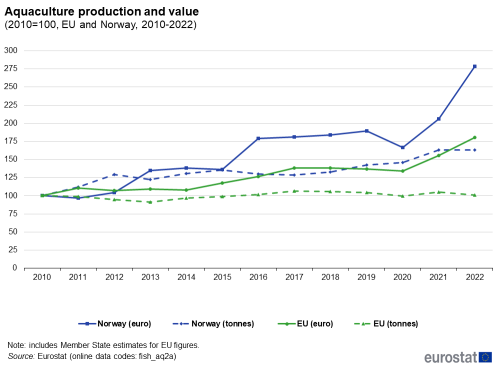
(2010=100, EU and Norway, 2010-2022)
Source: Eurostat (fish_aq2a)
Over this medium-term period, there was a sharp increase in both the volume and value of Norwegian aquaculture production. The volume of aquaculture production in Norway in 2022 was 63 % higher than in 2010, although there was no increase between 2021 and 2022 (-0.2 %). The value of output in 2022 was approaching triple that recorded in 2010, with the accelerated rises in 2021 and 2022 building on steadier increases in many other years over this period.
Source data for tables and graphs
Data sources
Fisheries statistics are collected by Eurostat from official national sources for the EU countries and members of the European Economic Area (EEA). The statistics are collected using internationally agreed concepts and definitions developed by the Coordinating Working Party (CWP), comprising Eurostat and several other international organisations with responsibilities in fisheries statistics.
Aquaculture production refers to the farming of aquatic (freshwater or saltwater) organisms, under controlled conditions. Aquaculture implies some form of intervention in the natural rearing process such as regular stocking, feeding and protection from predators. Farming also implies individual or corporate ownership of the stock being cultivated.
The legal basis for aquaculture statistics is Regulation (EC) No 762/2008 of the European Parliament and of the Council of 9 July 2008. The legal basis for organic aquaculture is Council Regulation (EC) No 834/2007 of 28 June 2007 on organic production and labelling of organic products and Commission Regulation (EC) No 889/2008 of 5 September 2008 laying down detailed rules for its implementation.
Symbols
In order to improve readability, only the most significant meta-information has been included under the tables and figures. The following symbols are used, where necessary:
- Italic data value is forecasted, provisional or estimated and is likely to change
- ':' not available or confidential
- '-' not applicable
Context
The European Green Deal and the Farm to Fork Strategy underline the potential of farmed seafood as a source of protein for food and feed with a low-carbon footprint which has an important role to play in helping to build a sustainable food system. This sector can also help: decarbonise the economy; fight climate change and mitigate its impact; reduce pollution; contribute to better preserving ecosystems (in line with the objectives of the Biodiversity strategy and the Zero-pollution ambition for a toxic-free environment); and be part of a more circular management of resources. To this end, the European Commission produced strategic guidelines (COM(2021) 236 final) for a more sustainable and competitive EU aquaculture in May 2021 [4]
The European Commission has proposed a new fund to invest in the maritime economy and support fishing communities. The European Maritime and Fisheries Fund will continue to support the European fisheries sector towards more sustainable fishing practices, with a particular focus on supporting small-scale fishermen. It will co-finance projects alongside national funding streams, with each EU country receiving a share of the total budget.
Direct access to
- Catches in all fishing regions (tag00076)
- Catches in the north-west Atlantic (tag00079)
- Catches in the north-east Atlantic (tag00078)
- Catches in the eastern central Atlantic (tag00080)
- Catches in the Mediterranean (tag00081)
- Aquaculture production, Total (tag00075)
- Fishing fleet, Total engine power (tsdnr420)
- Fishing fleet, Total tonnage (tag00083)
- Fishing Fleet, Number of Vessels (tag00116)
- Catches by fishing area (fish_ca)
- Aquaculture production (fish_aq)
- Landings of fishery products (fish_ld)
- Fishing fleet (fish_fleet)
- Agriculture, forestry and fishery statistics — 2021 edition (statistical book)
- Aquaculture production by species (ESMS metadata file — fish_aq_esms)
- Catches by fishing area (ESMS metadata file — fish_ca_esms)
- Fishing fleet (ESMS metadata file — fish_fleet_esms)
- Catch statistics:
Regulation (EC) No 216/2009 of the European Parliament and of the Council of 11 March 2009 on the submission of nominal catch statistics by Member States fishing in certain areas other than those of the North Atlantic (Summary)
Regulation (EC) No 217/2009 of the European Parliament and of the Council of 11 March 2009 on the submission of catch and activity statistics by Member States fishing in the North-West Atlantic (Summary)
Regulation (EC) No 218/2009 of 11 March 2009 of the European Parliament and of the Council on the submission of nominal catch statistics by Member States fishing in the North-East Atlantic (Summary)
- Aquaculture:
Regulation (EC) No 762/2008 of the European Parliament and of the Council of 9 July 2008 on the submission by Member States of statistics on aquaculture and repealing Council Regulation (EC) No 788/96 (Summary)
- Landings:
Regulation (EC) No 1921/2006 of the European Parliament and of the Council of 18 December 2006 on the submission of data on the landings of fishery products in Member States (Summary)
- Fishing fleet:
Commission Regulation (EC) No 26/2004 of 30 December 2003 on the Community fishing fleet register
Commission Implementing Regulation (EU) 2017/218 of 6 February 2017 on Union fishing fleet register
Notes
- ↑ See, http://ec.europa.eu/fisheries/cfp/index_en.htm.
- ↑ For more information, see the maritime affairs section on the European Commission's website.
- ↑ The state of world fisheries and aquaculture, 2022 — FAO, available at [1].
- ↑ For more information, see the strategic guidelines from the European Commission.
